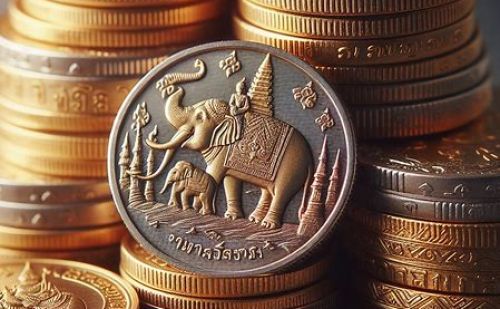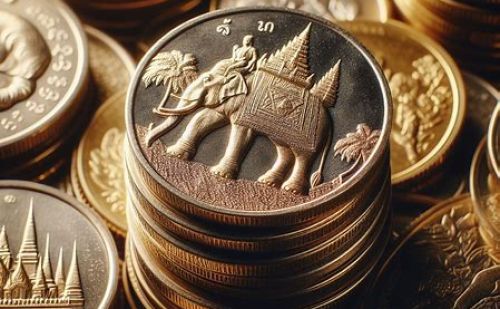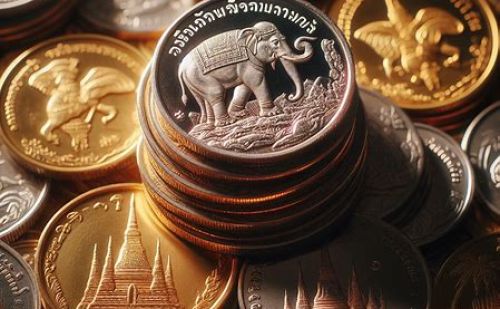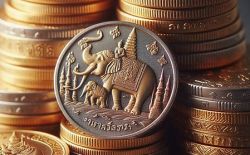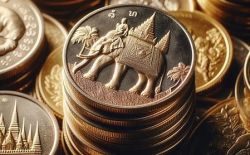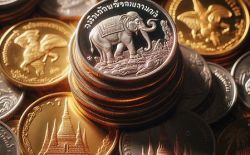Coins in Thailand
Coins in Thailand
The official currency of Thailand is the Thai Baht (THB), which is divided into 100 Satangs. The Bank of Thailand issues the banknotes and coins in the country. The banknotes come in denominations of 20, 50, 100, 500, and 1000 Bahts, while the coins come in denominations of 1, 2, 5, and 10 Bahts, as well as 25 and 50 Satangs. The coins feature the image of the King of Thailand on the obverse side, and various symbols of Thai culture and history on the reverse side. The coins have different shapes, sizes, and colors to help distinguish them from each other. Here is a table summarizing the features of the Thai coins:
Denomination Shape Size Color Reverse Image
1 Baht Round 20 mm Silver Wat Phra Kaew
2 Baht Round 21.75 mm Gold Golden Mount
5 Baht Round 24 mm Bimetallic (Silver center, Gold ring) Wat Benchamabophit
10 Baht Round 26 mm Bimetallic (Gold center, Silver ring) Wat Arun
25 Satang Scalloped 18 mm Brass Royal Ploughing Ceremony
50 Satang Scalloped 20 mm Brass Royal Chariot
Characteristics of coins in Thailand
Some of the characteristics of coins in Thailand are:
They have different shapes, sizes, and colors to help distinguish them from each other
They feature the image of the King of Thailand on the obverse side, and various symbols of Thai culture and history on the reverse side
They come in denominations of 1, 2, 5, and 10 Bahts, as well as 25 and 50 Satangs. One Baht is divisible into 100 Satangs
They have been issued by the Bank of Thailand since 1860, when Queen Victoria of England gave a small coining machine to King Rama the 4th
What is the history of Thai coins?
The history of Thai coins is very rich and diverse, reflecting the culture and civilization of Thailand. Here are some key points about the evolution of Thai coins:
Before the use of coins, people in Thailand traded goods by bartering or using commodities such as cowry shells, beads, grains, and gold and silver ornaments as mediums of exchange
The first coins that circulated in Thailand were from the Funan Kingdom, which was influenced by India. These coins were made of silver and had symbols of the monarchy and religion. They were used from the 1st to the 6th centuries AD
The Dvaravati Kingdom, which was also influenced by India, issued its own coins from the 7th to the 11th centuries AD. These coins were mostly made of copper and bronze and had images of Hindu deities, animals, and geometric patterns
The Srivijaya Kingdom, which was a maritime empire that dominated the trade in Southeast Asia, introduced gold coins to Thailand from the 7th to the 13th centuries AD. These coins were influenced by the coins of the Abbasid Caliphate and had Arabic inscriptions and Islamic motifs
The Sukhothai Kingdom, which was the first independent Thai state, established a unique type of currency known as pod duang or bullet money. These were pieces of solid silver cast to various weights and shapes, such as boats, fish, flowers, and animals. They were used from the 13th to the 19th centuries AD
The Ayutthaya Kingdom, which was the second Thai state and a major power in Southeast Asia, continued to use pod duang as the main currency, but also introduced tin coins called pitis. These coins were round or square and had a hole in the center. They were used as small change and for paying taxes
The Thonburi Kingdom, which was a short-lived state that emerged after the fall of Ayutthaya, also used pod duang and pitis, but also experimented with flat coins made of copper and lead. These coins had the image of King Taksin and the name of the city on one side, and the name of the mint and the date on the other side. They were the first coins to bear Thai inscriptions and dates
The Rattanakosin Kingdom, which was the third and final Thai state and the predecessor of modern Thailand, introduced the decimal system and modern coinage. This was done by King Mongkut, who received a coining machine from Queen Victoria of England in 1857. The first series of flat coins were issued in 1860 and had the portrait of the king and the name of the country on one side, and the denomination and the royal emblem on the other side. They were made of silver, copper, and nickel and came in denominations of 1, 2, 4, and 8 atts (1/64 of a baht), and 1/8, 1/4, 1/2, and 1 baht
The decimal system was officially adopted in 1897, when one baht was divided into 100 satang. The first series of decimal coins were issued in 1908 and had the portrait of King Chulalongkorn and the name of the country on one side, and the denomination and the garuda (the royal symbol) on the other side. They were made of silver, copper, and nickel and came in denominations of 1, 5, 10, 25, and 50 satang, and 1 baht
The coinage of Thailand has undergone several changes since then, reflecting the political and economic developments of the country. Some of the notable changes include the introduction of aluminum coins in 1942, the change of the country’s name from Siam to Thailand in 1939 and 1949, the change of the portrait and title of the king according to the succession of the monarchy, the introduction of bimetallic coins in 1987, and the introduction of commemorative and special issue coins for various occasions
What is the oldest Thai coin?
According to the web search results, the oldest Thai coin was from the Funan Kingdom, which was influenced by India. These coins were made of silver and had symbols of the monarchy and religion. They were used from the 1st to the 6th centuries AD
What is the value of Thai coins?
The value of Thai coins depends on the denomination, the year, the material, and the condition of the coin. According to the web search results, Thailand uses eight types of coins that range from 10 satang (0.1 baht or ~0.003 USD) to 10 baht (~0.3 USD). One baht is divisible into 100 satang. Some of the older coins made of silver or gold may have higher value for collectors, depending on their rarity and quality. You can check the online catalogs or the coin museum for more information about the specific coins and their values
How do I identify counterfeit Thai coins?
Identifying counterfeit Thai coins can be tricky, but there are some ways to spot them. Here are some tips based on the web search results:
Check the seam. Fake coins often have a seam around the edge, indicating that they were cast from a mold. Genuine coins are minted from metal blanks and do not have a seam
Check the markings. Fake coins may have incorrect or missing mintmarks, dates, inscriptions, or symbols. Compare the coin to a picture of a genuine coin of the same type and look for any discrepancies
Check the relief. Fake coins may have a different relief (the height of the design) than genuine coins. Stack the coin with other coins of the same type and see if they align. If the coin is too high or too low, it may be a fake
Check the magnetism. Fake coins may be made of magnetic metals, such as iron or steel. Genuine coins made of silver, gold, copper, or nickel are not magnetic. Use a magnet to test the coin and see if it is attracted or not
Check the melting. Silver is a good conductor of heat and will melt an ice cube quickly. Fake coins made of other metals may not have the same effect. Place an ice cube on the coin and see how fast it melts
These are some of the common methods to detect counterfeit coins, but they are not foolproof. Some fake coins may be very well-made and hard to distinguish from genuine ones. The best way to avoid buying fake coins is to purchase from reputable dealers or have the coins authenticated by a professional grading service, such as NGC or PCGS

